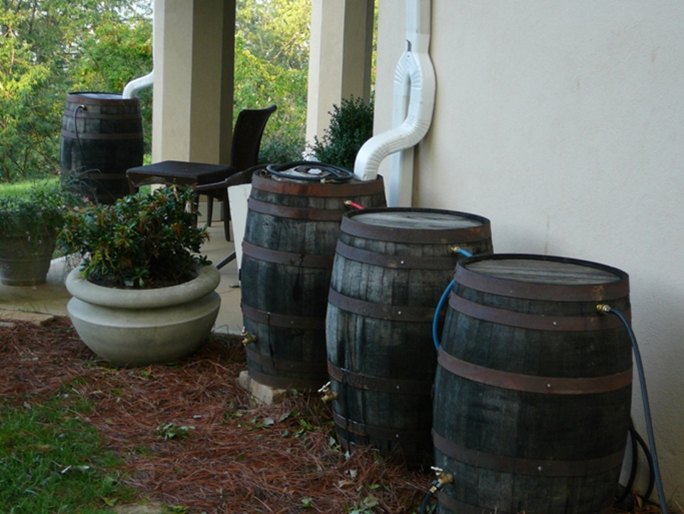Rainwater is a wonderful resource, but in urban and suburban areas it can also cause problems. We have a lot of paved surfaces and land contoured to send water away instead of absorbing it, so when we get a lot of rain, the only place it can go is into our sewers. In a significant rainfall, storm water will overload the system and send raw sewage into our waterways in what is known as a combined sewer overflow. In another blog post, we talked about how green roofs can go a long way to help keep this rainwater from overwhelming our system, but for many a green roof may not be a practical solution. So is there anything you can do to help capture rainwater at home? There sure is! Let’s look at four things you can do: two of them are simple, and two are more ambitious.
Add a Rain Barrel
Chances are you’ve seen a rain barrel attached to a downspout somewhere – maybe at a park, a school, or your eco-friendly neighbor’s house. Rain barrels collect rain from your roof to be used later in your landscape. In addition to keeping that water out of the sewer, it also reduces the amount of water you need from the faucet to keep your plants green and happy – a double win!
A well-designed rain barrel is more than just a container that collects water. To work well, it needs to prevent mosquito breeding, filter out debris, stand up to extreme weather, and more. It’s best to buy a container specifically designed to act as a rain barrel. For tips on what to look for, check out this information from The Watershed or from our friends at the Cincinnati Civic Garden Center.
Please note that water from your rain barrel should not be used on herbs or on fruits and vegetables before harvesting! The water may pick up contaminants from your roof that don’t pose a serious threat on your property, but you don’t want to eat them. This water can safely be used on lawns, trees, and flowers, though.
Plant a Tree
A mature tree can capture 500 gallons of water on its leaves and branches during a storm! While it may take a few years for it to reach that level, it’s never too early to plant a tree and start enjoying its many benefits. In addition to capturing rainwater, trees can also reduce energy costs, improve your mental health, and more.
Late summer and fall are great times to plant trees. To get the most benefit and the least headache from your tree, we recommend planting a native species and picking the right type and the right spot for your yard. A native species should be able to tolerate our local weather and soil conditions. Make sure you think about the mature size of the tree when you plant it so it doesn’t grow into anything else. For more information, check out lists of native trees for Ohio and Kentucky or try out the Arbor Day Foundation’s tree choosing tools.
Build a Rain Garden
Now we move on to some bigger projects. Rain gardens are planting beds designed to absorb water that would otherwise end up in running into storm drains. Placement is key for a rain garden to have an impact. A rain garden needs to be placed in the path of the water flowing from an impervious surface (such as a patio or driveway) to the storm drains. Rain gardens often feature native plant species since they are hardy and low-maintenance, so they are also helpful for feeding local wildlife and pollinators. Learn more about rain gardens in this detailed how-to guide from Ohio State University.
Install Permeable Pavers
Another higher input project would be installing permeable pavers. Permeable pavers create a stable, functional surface while letting water filter through instead of running off. They can be used anywhere traditional pavers are used, such as patios, walkways, and driveways. Pervious and porous pavers have a similar function with a slightly different method. With constant changes in technology and the growing popularity of sustainable landscape solutions, there are more options than ever for attractive and functional permeable, pervious, and porous pavers. If you were already planning on a larger landscape renovation, this technology is something to consider. Learn more about stormwater filtering paving systems.
Water management is our specialty, so if you’re considering a project to help manage storm water on your property or just want to learn more, contact us!
